Mythologies By Time Period
Seven gods who decree: An, Enlil, Enki, Ninhursag, Nanna, Utu, and Inanna.
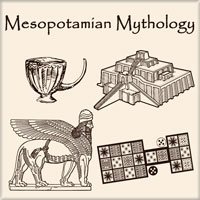
Mesopotamian Religion
Mesopotamian religion refers to the religious beliefs and practices of the civilizations of ancient Mesopotamia, particularly Sumer, Akkad, Assyria and Babylonia between circa 3500 BC and 400 AD, after which they largely gave way to Syriac Christianity.
Some of the most famous myths of Mesopotamian mythology include the creation myth Enuma Elish, the epic of Gilgamesh, and the story of Inanna's descent to the underworld. Enuma Elish describes the creation of the world and the gods by the god Marduk, while the epic of Gilgamesh tells the story of a king's quest for immortality. The story of Inanna's descent to the underworld tells of the goddess's journey to the land of the dead and her eventual return to the world of the living. Other notable myths include the story of the god Enki and the goddess Ninhursag, the myth of Ishtar's descent to the underworld, and the story of the god Dumuzid and his sister Geshtinanna.
The Epic of Gilgamesh
The Epic of Gilgamesh is one of the most famous and important works of ancient Mesopotamian literature. It is an epic poem that tells the story of Gilgamesh, the king of Uruk, and his quest for immortality. The poem is thought to have been written around 2100 BCE, in the Sumerian language, but it was later translated into Akkadian.
The epic tells the story of Gilgamesh's adventures, including his friendship with the wild man Enkidu and their journey to the Cedar Forest to fight the monster Humbaba. After Enkidu's death, Gilgamesh becomes obsessed with the fear of his own mortality and sets out on a journey to find the secret of immortality. He eventually meets Utnapishtim, the only human who has been granted immortality by the gods, and learns the secret of eternal life but fails to achieve it.
The epic also explores themes of friendship, loss, and the human condition, and it is considered one of the earliest known works of literature in world history. The poem was widely read in ancient Mesopotamia and had a significant influence on later literature in the region. The epic of Gilgamesh is still widely read and studied today, both for its historical and literary significance.
Apophis was perhaps the only Egyptian god very powerful, was not worshiped but feared.
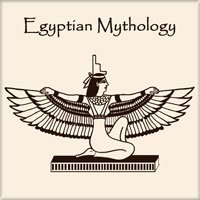
Egyptian mythology is the collection of myths from ancient Egypt, which describe the actions of the Egyptian gods as a means of understanding the world. The beliefs that these myths express are an important part of ancient Egyptian religion. Myths appear frequently in Egyptian writings and art, particularly in short stories and in religious material such as hymns, ritual texts, funerary texts, and temple decoration. These sources rarely contain a complete account of a myth and often describe only brief fragments.
Some of the most famous myths of Egyptian mythology include the story of Ra and the creation of the world, the story of Osiris, Isis, and Horus, and the story of the god Anubis and the weighing of the heart.
The story of Ra and the creation of the world describes how the sun god Ra emerged from the chaos of Nun to create the world and the gods. The story of Osiris, Isis, and Horus tells of the murder of Osiris, the god of the underworld, by his brother Set, and how Osiris's wife Isis and son Horus sought to avenge his death and restore him to power.
The story of Anubis and the weighing of the heart is a myth that describes the judgement of the dead in the afterlife. It tells how the god Anubis would weigh the hearts of the deceased against the feather of Ma'at, the goddess of truth and justice, to determine whether they were worthy of entering the afterlife.
Other notable myths in Egyptian mythology include the story of the god Horus and his battles with his uncle Seth, the myth of the goddess Hathor, and the story of the god Ra and the serpent Apep.
These myths play a central role in Ancient Egyptian religion and were widely known among the ancient Egyptians. They were often depicted in art and were performed in temple rituals. They also played a significant role in shaping the culture, beliefs, and worldview of ancient Egyptians.The main theme of Persian mythology was the battle between good and evil.
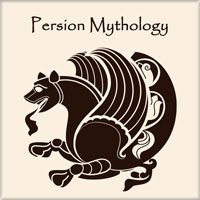
Persian mythology are traditional tales and stories of ancient origin, all involving extraordinary or supernatural beings. Drawn from the legendary past of Iran, they reflect the attitudes of the society to which they first belonged - attitudes towards the confrontation of good and evil, the actions of the gods, yazats (lesser gods), and the exploits of heroes and fabulous creatures. Myths play a crucial part in Iranian culture and our understanding of them is increased when we consider them within the context of Iranian history.
Persian mythology, also known as Zoroastrianism, has a rich collection of myths and legends that have been passed down for thousands of years. Some of the most famous myths of Persian mythology include:
- The story of Zoroaster: This is the story of the prophet Zoroaster, who received a revelation from Ahura Mazda, the god of wisdom and goodness, and who taught the principles of the good religion.
- The Battle of the Gods: The Persian mythology tells of a great battle between the forces of good and evil, led by Ahura Mazda and Angra Mainyu respectively. This battle is said to have been fought to determine the fate of humanity and the world.
- The story of Yima: This is the story of the first man on earth, Yima, who was tasked by Ahura Mazda to create a paradise on earth and protect humanity from the forces of evil.
- The story of Fereydun and the dragon: This is the story of Fereydun, a Persian hero who fought and defeated a dragon to save his people.
- The story of Afrasiyab: Afrasiyab is the king of the demons and the archenemy of the Persian king, Iran. The story of Afrasiyab and Iran's battles is a recurrent theme in Persian mythology and literature.
- The story of Jamshid: Jamshid is a king of Persia who becomes arrogant and loses the favor of the gods and his kingdom.
These myths are part of the Zoroastrian religion, which was the dominant religion in Persia before the arrival of Islam. They were passed down through oral tradition and were later recorded in the sacred texts of the Avesta. They continue to be an important part of Persian culture and are still referenced in modern literature and art.
Hittite sun goddess, the principal deity and patron of the Hittite empire and monarchy.

Hittite mythology and Hittite religion were the religious beliefs and practices of the Hittites, who created an empire centered in what is now Turkey from c. 1600 BC to 1180 BC.
Hittite mythology
Hittite mythology is the set of myths and religious beliefs of the ancient Hittites, an Indo-European people who lived in Anatolia (modern-day Turkey) from around 1600 BCE to 1200 BCE. Some of the most famous myths of Hittite mythology include:
-
The story of Kumarbi
This is the Hittite version of the "cosmogonic cycle" which tells the story of the god Kumarbi, who overthrows his father Anu and becomes the ruler of the gods. Kumarbi also impregnates the mother goddess and gives birth to the storm god Teshub and other deities.
-
The story of Teshub and the dragon
The god Teshub fought and defeated the dragon Illuyanka, a symbol of chaos and destructive forces.
-
The story of Telipinu
This is the story of the god Telipinu, who is responsible for the fertility of the land and the well-being of the people. Telipinu goes into a rage and causes a drought, but he is eventually placated and returns to bring fertility back to the land.
-
The story of the Sun-goddess of Arinna
This is the story of the Sun-goddess of Arinna, one of the most important deities of the Hittite pantheon. She is the goddess of the sun, and her daily journey across the sky was seen as a representation of the cycle of life and death.
-
The story of the god of the underworld
The god of the underworld, known as Allani or "the god of the land of the dead" is an important figure in Hittite mythology. He is responsible for the afterlife and the fate of the souls of the dead.
These myths were an important part of Hittite religion and were often depicted in art and referenced in religious texts and rituals. They played a significant role in shaping the beliefs and worldview of the Hittite people. The Hittite myths were passed down through oral tradition, and many of them were recorded in the Hittite language on clay tablets. They are still studied today for their historical and cultural significance.
Sun Wukong - the monkey king. The most famous chinese myth
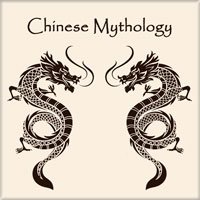
Chinese mythology refers to those myths found in the historical geographic area of China: these include myths in Chinese and other languages, as transmitted by Han Chinese and other ethnic groups, which have their own languages and myths.
Chinese mythology is a collection of myths, legends, and traditional stories that have been passed down over the centuries in China. Here are a few examples of famous myths from Chinese mythology:
- The story of the Jade Emperor: The Jade Emperor is the highest god in Chinese mythology and is known as the ruler of all gods and spirits. He is often depicted as a wise and benevolent ruler who governs the universe with fairness and justice.
- The story of the Four Symbols: The Four Symbols are four powerful creatures in Chinese mythology, each representing a different season and cardinal direction. They are the Black Tortoise, the White Tiger, the Blue Dragon, and the Red Phoenix.
- The story of Nüwa: Nüwa is a goddess in Chinese mythology and is known as the mother of mankind. She is often depicted as the creator of the world and the one who mends the sky after natural disasters.
- The story of Sun Wukong: Sun Wukong is a monkey king and a powerful figure in Chinese mythology. He is known for his intelligence, strength, and his ability to shape-shift. He is one of the most important characters in the classic novel "Journey to the West"
- The story of the Eight Immortals: The story of the Eight Immortals in Chinese mythology is a popular legend that tells of a group of eight legendary figures who possess supernatural powers and are able to achieve immortality. Each of the eight immortals has their own unique abilities and stories, but they are all united by their quest for enlightenment and their desire to help the people.
Most Indian myths and legends have been derived from two of its epic poems, Mahabharata and Ramayana, as well as from the ancient Hindu texts, Puranas.
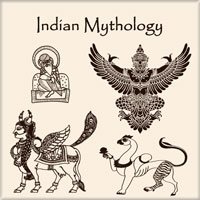
In India a different worldview evolved over four thousand years, with the concepts responding to various sociocultural phenomena and transforming with the words of wise men to satisfy the needs of the local population
There are many famous myths in Indian mythology, here are a few examples:
- The Ramayana, which tells the story of Prince Rama and his rescue of his wife, Sita, from the demon king, Ravana.
- The Mahabharata, which is one of the longest epic poems in the world and tells the story of a dynastic struggle for the throne of Hastinapura.
- The story of Lord Vishnu taking the form of a fish to save the world from a great flood.
- The story of Lord Shiva and his consort, Parvati, and their son, Lord Ganesha.
- The story of Lord Krishna, who is considered a supreme deity in Hinduism and is known for his wisdom and his role in the Mahabharata.
- The story of the Trimurti, which tells of the three main gods in Hinduism- Brahma, Vishnu, and Shiva.
- The story of creation according to Hindu mythology is also an important one, which explains how the world and all living beings came into being.
The Greek gods live in a cloud palace on Mount Olympus
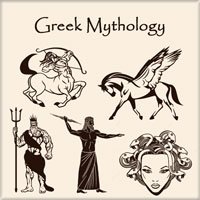
Greek mythology is the body of myths and teachings that belong to the ancient Greeks, concerning their gods and heroes, the nature of the world, and the origins and significance of their own cult and ritual practices.
Famous Myths of Greek Mythology
-
The myth of the Titans
The Titans were the gods that preceded the Olympians, they were the children of the primordial deities Uranus and Gaia. The Titans were overthrown by Zeus and the Olympians in a ten-year war called the Titanomachy.
-
The myth of the Olympians
The Olympians were the principal gods of the Greek pantheon, who lived on Mount Olympus. The most famous Olympians were Zeus, Hera, Poseidon, Demeter, Athena, Apollo, Artemis, Ares, Aphrodite, Hephaestus, Hermes, Dionysus, and Hestia.
-
The myth of the Minotaur
The Minotaur was a creature with the body of a man and the head of a bull, that was kept in the Labyrinth, a maze built by Daedalus for King Minos of Crete. The Minotaur was eventually killed by the Athenian hero Theseus.
-
The myth of the Labors of Hercules
Hercules, also known as Heracles, was a demigod who performed twelve impossible tasks, known as the Labors of Hercules, as atonement for killing his family. These tasks included slaying the Nemean Lion, capturing the Erymanthian Boar, and cleaning the Augean Stables.
-
The myth of the Argonauts
The Argonauts were a band of heroes who sailed with Jason on the ship Argo to retrieve the Golden Fleece, which was guarded by a dragon. The Argonauts included heroes such as Heracles, Orpheus, and Castor and Pollux.
-
The myth of the Trojan War
The Trojan War was a legendary war fought between the city of Troy and the Greeks. It was said to have been sparked by the abduction of Helen, the wife of King Menelaus of Sparta, by the Trojan prince Paris.
Greek Mythology Heritage Tree
This heritage tree represents some of the key figures in Greek mythology, particularly the Olympian gods and their ancestors.
- Titan Cronus
- Zeus
- Athena
- Apollo
- Artemis
- Hermes
- Persephone (with Demeter)
- Dionysus
- Hera
- Hephaestus
- Ares
- Hebe
- Poseidon
- Triton
- Polyphemus
- Hades
- Zeus
Janus as the god of all beginnings and believe that his association with doorways is derivative
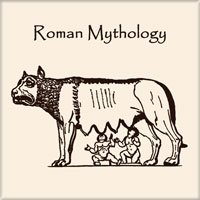
Roman mythology is a collection of traditional stories, beliefs, and religious practices that ancient Romans used to explain the world around them and the natural phenomena they observed. The Roman myths are heavily influenced by the myths of the ancient Greeks, as the Romans adopted many of the Greek gods and goddesses and adapted them to their own culture. Here are some famous myths of Roman mythology:
Famous Myths of Roman Mythology
-
The myth of Romulus and Remus
This is the story of the twin brothers who were suckled by a she-wolf and went on to found the city of Rome.
-
The myth of Jupiter and his brothers
Jupiter, the king of the gods, overthrew his father Saturn and his brothers to become the ruler of the gods.
-
The myth of Apollo and Daphne
This is the story of the god of poetry and music, Apollo, who falls in love with the nymph Daphne, who turns into a laurel tree to escape him.
-
The myth of Venus and Adonis
This is the story of the goddess of love and beauty, Venus, who falls in love with the mortal Adonis.
-
The myth of Mars and Rhea Silvia
This is the story of the god of war, Mars, who impregnates Rhea Silvia, the Vestal Virgin, and the mother of the twins Romulus and Remus.
-
The myth of Mercury and Herse
This is the story of the messenger of the gods, Mercury, who seduces the mortal Herse, and the daughter of the king of Athens.
-
The myth of Saturn and Ops
This is the story of the god of agriculture and the ruler of the Golden Age, Saturn, who marries Ops, the goddess of fertility and abundance.
Jupiter, Juno, and Minerva were the three main gods
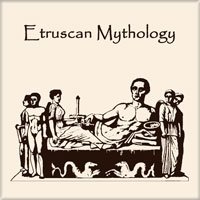
Etruscan mythology comprises a set of stories, beliefs, and religious practices of the Etruscan civilization, originating in the 7th century BC from the preceding Iron Age Villanovan culture, with its influences in the mythology of ancient Greece and Phoenicia, and sharing similarities with concurrent Roman mythology.
The Etruscan civilization existed in ancient Italy from around the 8th century BCE to the 3rd century BCE, and its myths and religious beliefs have been largely lost to time. However, some of the myths that have been reconstructed from the surviving evidence include:Famous Myths of Etruscan Mythology
-
The myth of Tages
Tages was a child-god who emerged from the plowed fields and taught the Etruscans divination and the art of reading the will of the gods.
-
The myth of Charun
Charun was the Etruscan god of death, and was often depicted as a fearsome figure with a hammer, ready to strike the souls of the dead.
-
The myth of Turms
Turms was the Etruscan equivalent of Hermes, the Greek messenger of the gods. He was known for his speed and agility and was often depicted with winged sandals.
-
The myth of Menrva
Menrva was the Etruscan goddess of wisdom, war, and the arts. She was often equated with the Greek Athena and the Roman Minerva.
-
The myth of Laran
Laran was the Etruscan god of war, and was often depicted as a fierce warrior, ready to defend his people.
Celtic mythology refers to the polytheistic religious beliefs of the Celts

Celtic mythology is the mythology of Celtic polytheism, the religion of the Iron Age Celts.Like other Iron Age Europeans, the early Celts maintained a polytheistic mythology and religious structure.
Celts were one of the most feared and admired peoples of ancient Europe. Ireland was a rich and fertile land with ancient and sophisticated culture. The monks of Ireland became famous scribes who wrote down native Irish stories of gods and goddesses battling for the control of island in epic wars, heroes engaged in endless combat to win undying glory, to voyage across the sea to magical islands. Divine women with the gift of their sexuality could control the power of kings.
Famous Myths of Celtic Mythology
-
The myth of Cuchulainn
Cuchulainn is a legendary warrior of Irish mythology, known for his superhuman strength and courage.
-
The myth of The Children of Lir
A tragic tale of a king who turned his children into swans for 900 years, as punishment for his stepmother's cruelty towards them.
-
The myth of The Tuatha Dé Danann
The Tuatha Dé Danann are a race of powerful and magical beings in Irish mythology, who were said to have inhabited Ireland before the arrival of the Celts.
-
The myth of The Loch Ness Monster
The Loch Ness Monster is a mythical creature that is said to reside in Loch Ness in Scotland, it's a creature of legend, described as giant serpent or dragon-like beast.
-
The myth of King Arthur
King Arthur is a legendary figure in British mythology, who is said to have led the defense of Britain against the Saxon invaders in the late 5th and early 6th centuries.
Perun is undoubtedly the highest god of the Slavic Pantheon.
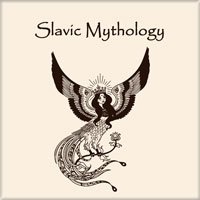
Slavic paganism or Slavic religion define the religious beliefs, godlores and ritual practices of the Slavs before the formal Christianisation of their ruling elites.
Famous Myths of Slavic Mythology
-
The myth of Perun
Perun is the god of thunder and lightning in Slavic mythology, he is often seen as the chief deity and protector of the tribe.
-
The myth of Veles
Veles is the god of earth, waters, and the underworld in Slavic mythology, he is often associated with the power of magic and witchcraft.
-
The myth of Svarog
Svarog is the god of fire, metalworking and fate in Slavic mythology, he was considered as the father of the gods and the creator of the world.
-
The myth of Dazhbog
Dazhbog is the god of the sun, warmth and light in Slavic mythology, he was often associated with the power of fertility and agriculture.
-
The myth of Baba Yaga
Baba Yaga is a witch-like figure in Slavic mythology, known for her supernatural powers and her ability to fly. She is sometimes seen as a helpful figure, while other times she is seen as a malevolent force.
-
The myth of Kostroma
Kostroma is a goddess of fertility and love in Slavic mythology, she was often associated with the power of spring and renewal.
Some say that Kaaba was built by the angels.
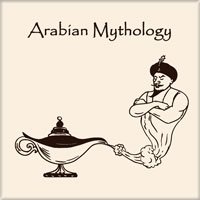
Religion in pre-Islamic Arabia was a mix of polytheism, Christianity, Judaism, and Iranian religions. Arab polytheism, the dominant form of religion in pre-Islamic Arabia, was based on veneration of deities and other rituals.
Famous Myths of Arabian Mythology
-
The myth of djinn
The djinn are supernatural spirits in Arabian mythology that can be good or evil, they are often associated with fire and can take human form.
-
The myth of Al-Khidr
Al-Khidr is a mysterious figure in Islamic mythology, also known as the "Green Man." He is believed to have knowledge of all things and is often associated with water and the afterlife.
-
The myth of Harut and Marut
Harut and Marut were two angels in Islamic mythology who were sent to Earth to test the faith of the people. They were tempted by the devil and ultimately fell from grace.
-
The myth of Iblis
Iblis is the Islamic equivalent of Satan. He was once an angel, but was cast out of heaven for his pride and refusal to bow to Adam.
-
The myth of the seven sleepers
The seven sleepers is a story from Islamic tradition about seven young men who sought refuge in a cave to escape persecution. They fell asleep and awoke years later, to find that the world had changed.
-
The myth of Solomon
Solomon is a prophet in Islamic and Jewish mythology, who is known for his wisdom and power. He is said to have had control over the djinn, birds, and the wind.
Mythologies By Region
The Bantu believe that fire was brought to earth by a god or goddess, who gave it to humans as a gift.

The Bantu Mythology
The Bantu mythology is the system of myths and legends of the Bantu peoples of Africa. Although Bantu peoples account for several hundred different ethnic groups, there is a high degree of homogeneity in Bantu cultures and mythologies, just as in Bantu languages.
The Bantu people, who live in many parts of Africa, have a rich and diverse mythology that includes many different stories and legends. Here are a few examples of famous myths from Bantu mythology: The Creation Myth
The Bantu believe that the world was created by a god or gods, who formed the earth, sky, and all living things. Different Bantu groups have different creation stories, but they often involve the god or gods creating the world out of chaos or darkness.
The Myth of the First Human
According to Bantu legend, the first human, named Likumbi, was created by the god or gods. Different Bantu groups have different stories about how the first human was created, but they often involve the god or gods fashioning the first human out of clay or dust.
The Myth of the First Fire
The Bantu believe that fire was brought to earth by a god or goddess, who gave it to humans as a gift. Different Bantu groups have different stories about how fire was brought to earth, but they often involve a trickster figure stealing fire from the gods or a god or goddess giving fire to humans as a reward for good behavior.
The Myth of the First Rain
The Bantu believe that the first rain was brought to the world by a god or goddess, who sent it to earth as a gift. Different Bantu groups have different stories about how rain was brought to earth, but they often involve a god or goddess opening up the sky to let the rain fall or sending a messenger to earth to bring the rain.
The Myth of the Afterlife
The Bantu people have different beliefs about the afterlife, but some of the most common are a belief in a heaven and hell, a belief that the dead go to the land of the ancestors or a belief that the soul is reincarnated.
The people of the lightning / Sons of Bushongo
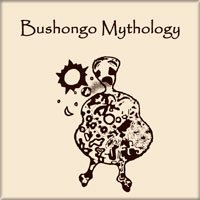
The Bushongo or Songora are an ethnic group from the Congo River and surrounding areas. The creation god(or chembe) in Bushongo mythology is called Bumba.
The Bushongo people, who live in what is now the Democratic Republic of Congo, have a rich and diverse mythology that includes many different stories and legends. Here are a few examples of famous myths from Bushongo mythology:
The creation myth:
The Bushongo believe that the world was created by a god named Mbidi Kiluwe, who formed the earth, sky, and all living things.
The myth of the first man:
According to Bushongo legend, the first man, named Kondi, was created by Mbidi Kiluwe and was given the task of populating the world.
The myth of the first woman:
The Bushongo believe that the first woman, named Luba, was created by Mbidi Kiluwe and was given the task of helping Kondi to populate the world.
The myth of the first fire:
The Bushongo believe that fire was brought to earth by a god named Lumona, who gave it to humans as a gift.
The myth of the first death:
The Bushongo believe that death was brought to the world by a god named Cagn, who punished humans for their disobedience.
The myth of the first rain:
The Bushongo believe that the first rain was brought to the world by a god named Cagn, who punished humans for their disobedience.
Please note that this is just a small sample of the Bushongo mythology stories, and there are many more myths and legends that are important to the Bushongo people.
Mbuti (Bambuti) mythology is the mythology of the African Mbuti (also known as Bambuti) Pygmies of Congo.
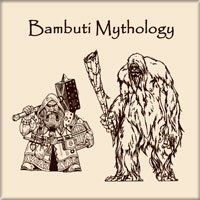
Mbuti (Bambuti) mythology is the mythology of the African Mbuti (also known as Bambuti) Pygmies of Congo. The Bambuti people, also known as the Pygmies, are a group of indigenous people who live in the Ituri rainforest in the Democratic Republic of Congo. They have a rich and diverse mythology that reflects their culture and beliefs. Here are a few examples of famous myths from Bambuti mythology:
- The creation myth: The Bambuti believe that the world was created by a god named Nkuba, who formed the earth, sky, and all living things. They also believe that Nkuba created the first man and woman, and gave them the task of populating the world.
- The myth of the first fire: The Bambuti believe that fire was brought to earth by a trickster figure named Mokèlé-mbèmbé, who stole it from the gods and gave it to humans.
- The myth of the first hunting: The Bambuti believe that hunting was taught to humans by a god named Woot, who also taught them how to make arrows, spears, and traps.
- The myth of the first death: The Bambuti believe that death was brought to the world by a god named Nkondi, who punished humans for their disobedience.
- The myth of the first rain: The Bambuti believe that the first rain was brought to the world by a god named Nkondi, who punished humans for their disobedience.
- The myth of the afterlife: The Bambuti believe that the souls of the dead go to the land of the ancestors, which is a place similar to the earth but more beautiful and peaceful. They also believe that the souls of the wicked go to a place of punishment.
Please note that this is just a small sample of the Bambuti mythology stories, and there are many more myths and legends that are important to the Bambuti people.
The Lugbara people believe in a single creator, called Woot
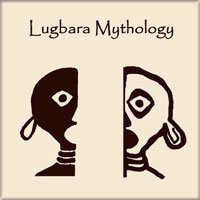
The Lugbara people are an ethnic group living in the Democratic Republic of the Congo, Uganda, and South Sudan. They have a rich mythology that has been passed down through generations, and their stories are a source of pride and identity for the Lugbara people.
The Lugbara people believe in a single creator, called Woot, who is responsible for the creation of the world and all its inhabitants. They also believe in a pantheon of lesser gods, each with their own sphere of influence. For example, Nyambe is the god of rain, and there is also a god of war, a god of the hunt, and a god of love.
The Lugbara people also believe in a number of supernatural beings, such as spirits and ghosts. These beings can be benevolent or malevolent, and they often take the form of animals or other creatures. It is believed that these beings can influence the lives of humans, either for good or for ill.
The Lugbara people have a number of stories and legends about their gods and supernatural creatures. One of the most famous is the story of Nyambe and the Great Snake. According to the story, Nyambe was out hunting one day when he encountered a giant snake. Nyambe managed to defeat the snake, and as a reward, the gods gave him the power to control the weather and the seasons.
The stories and legends of the Lugbara people are an important part of their culture, and they are still told and retold to this day. They provide a fascinating insight into the beliefs and values of the Lugbara people, and offer a unique window into their history and mythology.
The Akamba people, who live in Kenya, have a rich and diverse mythology
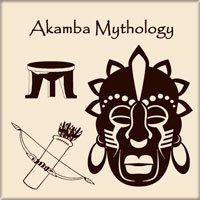
The Kamba or Akamba people are a Bantu ethnic group - or tribe - who live in the semi-arid formerly Eastern Province of Kenya stretching east from Nairobi to Tsavo and north up to Embu, Kenya.
The Akamba people, who live in Kenya, have a rich and diverse mythology that includes many different stories and legends. Here are a few examples of famous myths from Akamba mythology:
The creation myth:
The Akamba believe that the world was created by a god named Mulungu, who formed the earth and sky, the sun and moon, and all living things.
The myth of the first woman:
According to Akamba legend, the first woman, named Wambui, was created from a rib taken from the first man, named Kintu.
The myth of the first fire:
The Akamba believe that fire was brought to earth by a bird named Kibokolo, who stole it from the gods and gave it to humans.
The myth of the first fruit trees:
The Akamba believe that the first fruit trees were created by a goddess named Nzambi, who planted them in the garden of the first man and woman.
The myth of the first death:
The Akamba believe that death was brought to the world by a god named Kibuka, who punished humans for their disobedience.
The myth of the first rain:
The Akamba believe that the first rain was brought to the world by a god named Kibuka, who punished humans for their disobedience.
Please note that this is just a small sample of the Akamba mythology stories, and there are many more myths and legends that are important to the Akamba people.
Dinka mythology refers to the traditional religion and folk tales of the Dinka

Dinka mythology refers to the traditional religion and folk tales of the Dinka, or Muonyjang, ethnic group of South Sudan.
The supreme, creator god, Nhialic, is the god of the sky and rain, and the ruler of all the other gods and spirits. He is generally seen as distant from humans. Nhialic is also known as Jaak, Juong or Dyokin by other Nilotic groups such as the Nuer and Shilluk. Nhialac created ex-nihilo and rarely involves itself with the affairs of humans.
There are several versions of the Dinka creation myth which mainly concerns itself with the creation of humans. The first humans are Garang and Abuk. In some cases Nhialac created humans by blowing them out of its nose, other accounts say humans originated from the sky and were placed in the river where they came as fully formed adults. Other accounts say that humans were molded as clay figures and placed to mature in pots. Garang and Abuk were made out of the clay of Sudan.
Nhialac told them to multiply and that their children would die but would come back to life within 15 days. Garang protested that if nobody dies permanently then there would not be enough food. Nhialac then introduced permanent death. Nhialac commanded them to only plant one seed of grain a day or gave them one grain to eat a day. Being hungry everyday Abuk made a paste with the grain to make the food last longer. However, when Abuk disobeyed and planted more Nhialac cut the rope that connected Heaven and Earth.
The Lotuko are an ethnic group from South Sudan.
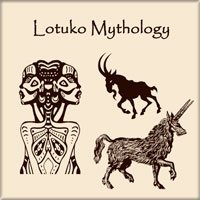
The Lotuko people are an ethnic group that live primarily in the Eastern Equatoria state of South Sudan. I couldn't find enough information about their mythology. However, the Lotuko people have a rich oral tradition that includes stories, fables, proverbs, and riddles, which are passed down from generation to generation. These stories often involve animals and spirits, and they are used to teach moral lessons and explain the origins of the Lotuko people and their customs. Lotuko people have a strong belief in traditional religion, ancestor worship and animism.
Top myths of Lotuko mythology
The Creation of the World
This myth tells the story of how the world was created by the god Akuji. He created the earth and the sky, and then filled the world with plants and animals. This myth teaches the Lotuko people the importance of respecting nature.
The Origin of the Crocodile
This myth tells of how a crocodile came to be. It is said that the god Akuji created the crocodile from a piece of wood. He then gave it the power to protect the people and their land.
The Great Flood
This myth tells of a great flood that wiped out all of humanity. It is said that the god Akuji sent the flood to punish mankind for their sins. The Lotuko people use this story to teach their children the importance of obedience and respect.
The Battle of the Sun and Moon
This myth tells of a battle between the sun and moon. The sun and moon fought for many days, until the sun was victorious. The Lotuko people believe that this story symbolizes the constant struggle between good and evil.
The Story of the First Man and Woman
This myth tells the story of the first man and woman. It is said that the god Akuji created the first man and woman from a piece of wood. This myth teaches the Lotuko people the importance of family and the value of human life.
The Origin of Death
This myth tells of the origin of death. It is said that the god Akuji created death in order to keep balance in the world. This story is used to remind the Lotuko people of the importance of living life to the fullest.
The Maasai mythology involves several beliefs of the Maasai people

The Maasai mythology involves several beliefs of the Maasai people, an ethnic group living in Kenya and Tanzania.
The Maasai people are a semi-nomadic ethnic group that lives in southern Kenya and northern Tanzania. They have a rich oral tradition that includes myths, legends, and stories that are passed down from generation to generation. Here are a few examples of famous myths from Maasai mythology:
The creation myth:
The Maasai believe that the world was created by Enkai, the god of the sky and rain. He created the first Maasai people and the animals, and he gave them all the land to live on.
The story of the rainbow:
The Maasai believe that the rainbow is a bridge between the world of the living and the world of the dead. The rainbow is said to be created by Enkai, and it is a sign that he is watching over the Maasai people.
The story of the baobab tree:
The Maasai believe that the baobab tree is sacred and that it was created by Enkai to provide food and shelter for the animals. They also believe that the tree is a source of wisdom and that it holds the secrets of the universe.
The story of the lion:
The Maasai believe that the lion is a sacred animal and that it is a symbol of strength and courage. They also believe that the lion is a messenger of Enkai and that it brings important messages to the Maasai people.
These myths, along with others, are used by the Maasai to explain the origins of their people and their customs and to reinforce their traditional beliefs and values.
The Maasai mythology involves several beliefs of the Maasai people
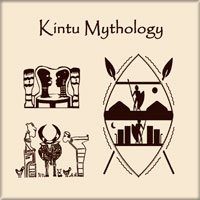
The Kintu, Kaikuzi, Warumbe mythology involves several beliefs of the Maasai people, an ethnic group living in Kenya and Tanzania
Kintu is a figure in the traditional mythology of the Ganda people of Uganda. According to the Ganda's traditional story, Kintu was the first human being created by the god, Ggulu. The story of Kintu is an important part of Ganda mythology, and it is used to explain the origins of the Ganda people and their customs.
The Kintu Myth Explained
The Kintu Myth explains how the first human came to be, how the first human was given a wife by the creator god, Ggulu, and how they were given the ability to procreate. The myth goes on to describe how Kintu and his wife, Nambi, had children, and how those children went on to become the ancestors of the Ganda people.
Kintu as the First Ancestor
In this story, Kintu is considered as the first ancestor of the Ganda people, and his children are considered as the founders of different Ganda tribes and clans. The story of Kintu is also used to explain the customs and traditions of the Ganda people, such as the importance of ancestor worship and the role of the clan in Ganda society.
Kintu as the Ancestor of the Buganda Kingdom
It is also believed that Kintu is the ancestor of the Buganda kingdom which is the largest kingdom in present day Uganda.
Somali mythology covers the beliefs, myths, legends and folk tales circulating in Somali
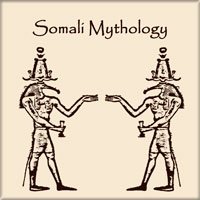
Somali Mythology
Somali mythology covers the beliefs, myths, legends and folk tales circulating in Somali society that were passed down to new generations in a timeline spanning several millennia.
Somali mythology includes a diverse set of stories and legends that reflect the culture and beliefs of the Somali people. Here are a few examples of famous myths from Somali mythology:
The Creation Myth
The Somali believe that the world was created by God (Waaq), who created the first human beings, the first animals, and the first plants.
The Myth of the First Woman
According to Somali legend, the first woman, named Hawo, was created from a rib taken from the first man, named Adaan.
The Myth of the First Fire
The Somali believe that fire was brought to earth by a bird named Shimbir, who stole it from the gods and gave it to humans.
The Myth of the First Ancestor
The Somali believe that the first ancestor, named Samaale, was the progenitor of all Somali clans.
The Myth of the First Death
The Somali believe that death was brought to the world by a god named Ebla, who punished humans for their disobedience.
The Myth of the First Rain
The Somali believe that the first rain was brought to the world by a god named Ebla, who punished humans for their disobedience.
Please note that these are just a few examples and there are many more myths and legends that are important to the Somali people, as Somali mythology is vast and diverse. Also, It's worth mentioning that a lot of the oral tradition was lost through the years.
Akan mythology is the traditional belief system of the Akan people of Ghana and Cote d'Ivoire.
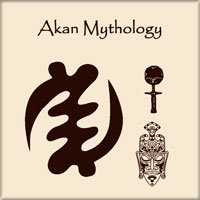
Akan mythology is the traditional belief system of the Akan people of Ghana and Cote d'Ivoire. Here are a few examples of famous myths from Akan mythology:
The story of Nyame
Nyame is the supreme god in Akan mythology and is believed to be the creator of the universe. He is often depicted as an old man with a white beard and is associated with wisdom, justice and the sky.
The story of Onyame and Asase Ya
Onyame is the god of the sky and the father of all gods and Asase Ya is the goddess of the earth and the mother of all living things. Together they are the parents of the other gods and goddesses in the Akan pantheon.
The story of Anansi
Anansi is a trickster figure in Akan mythology and is known for his cunning and wit. He is often depicted as a spider and is considered a bringer of wisdom and culture to the Akan people.
The story of Odomankoma
Odomankoma is the god of fate and destiny, who controls the fate of individuals, and also the god of wisdom, who is responsible for the knowledge and skills of the Akan people.
The story of Osrane
Osrane is the god of death and the afterlife. He is responsible for taking the souls of the dead to the afterlife.
These myths, along with others, are used by the Akan people to explain the origins of the world, the customs and traditions of the Akan people and to reinforce their traditional beliefs and values. The Akan people's traditional religion is based on ancestor worship, and the belief in a supreme being who created the universe.
The traditional religion and mythology of the San people

The Traditional Religion and Mythology of the San People
The Khoikhoi people, also known as the Khoisan, are a group of indigenous people who live in southern Africa. They have a rich and diverse mythology that reflects their culture and beliefs. Here are a few examples of famous myths from Khoikhoi mythology:
The Creation Myth
The Khoikhoi believe that the world was created by a god or gods, who formed the earth, sky, and all living things. Different Khoikhoi groups have different creation stories, but they often involve the god or gods creating the world out of chaos or darkness.
The Myth of the First Human
According to Khoikhoi legend, the first human, named /Kaggen, was created by the god or gods. Different Khoikhoi groups have different stories about how the first human was created, but they often involve the god or gods fashioning the first human out of clay or dust.
The Myth of the First Fire
The Khoikhoi believe that fire was brought to earth by a god or goddess, who gave it to humans as a gift. Different Khoikhoi groups have different stories about how fire was brought to earth, but they often involve a trickster figure stealing fire from the gods or a god or goddess giving fire to humans as a reward for good behavior.
The Myth of the First Rain
The Khoikhoi believe that the first rain was brought to the world by a god or goddess, who sent it to earth as a gift. Different Khoikhoi groups have different stories about how the first rain was brought to earth, but they often involve a god or goddess sending the rain to earth as a gift.
The Lozi people, who live in what is now Zambia, have a rich and diverse mythology
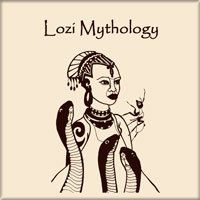
Lozi mythology gives legitimacy to the Lozi kingdom's foundations, by linking the monarchy and the people to a creator god, whom the Lozi call Nyambe.
The Lozi people, who live in what is now Zambia, have a rich and diverse mythology that reflects their culture and beliefs. Here are a few examples of famous myths from Lozi mythology:
The creation myth
The Lozi believe that the world was created by a god named Nyambe, who formed the earth, sky, and all living things. They also believe that Nyambe created the first man and woman, and gave them the task of populating the world.
The myth of the first fire
The Lozi believe that fire was brought to earth by a god named Mwali, who gave it to humans as a gift.
The myth of the first death
The Lozi believe that death was brought to the world by a god named Mwali, who punished humans for their disobedience.
The myth of the first rain
The Lozi believe that the first rain was brought to the world by a god named Mwali, who punished humans for their disobedience.
The myth of the afterlife
The Lozi believe that the souls of the dead go to the land of the ancestors, which is a place similar to the earth but more beautiful and peaceful. They also believe that the souls of the wicked go to a place of punishment.
The myth of the floods
The Lozi believe that the floods in the Barotse floodplain, where they live, are caused by the god Mwali's tears, which he shed when he was angry with people for their misdeeds.
Please note that this is just a small sample of the Lozi mythology stories, and there are many more myths and legends that are important to the Lozi people.
The Tumbuka people are an ethnic group that live primarily in northern Malawi
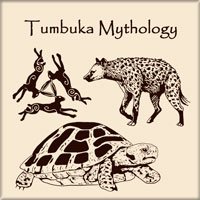
Tumbuka has many myths that constitute part of the Tumbuka cultural heritage.
These myths, told around fires at night, often to the accompaniment of drumming and choral responses, aim to teach children moral behavior and to entertain. The Tumbuka people are an ethnic group that live primarily in northern Malawi and eastern Zambia. Tumbuka mythology is rich with stories, myths and legends which are passed down from generation to generation through oral tradition. Some of the famous myths from Tumbuka mythology include:
The story of Mbulu:
Mbulu is the supreme being and creator of the Tumbuka people. He is often depicted as a powerful and benevolent god who watches over the Tumbuka people.
The story of Mwali:
Mwali is the god of war and is known for his strength and bravery. He is often invoked in times of conflict and is considered a protector of the Tumbuka people.
The story of Mlengi:
Mlengi is the god of fertility and is responsible for the abundance of crops and the growth of the Tumbuka people.
The story of Chaminuka:
Chaminuka is a powerful and wise ancestor who is considered to be the founder of the Tumbuka people. He is often invoked for guidance and wisdom.
The story of Mpherere:
Mpherere is the god of thunder and lightning and is known for his power and fury. He is often invoked to bring rain and is considered a protector of the Tumbuka people.
These myths, along with others, are used by the Tumbuka people to explain the origins of their people and their customs and to reinforce their traditional beliefs and values. Tumbuka people have a strong belief in traditional religion, ancestor worship and animism.
Zulu mythology contains numerous deities commonly associated with animals
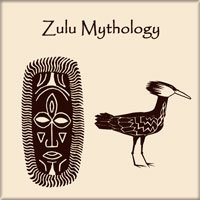
Zulu mythology contains numerous deities commonly associated with animals or general classes of natural phenomena. Unkulunkulu is the highest God and is the creator of humanity The Zulu people are an ethnic group that live primarily in South Africa, and their mythology is deeply rooted in their culture and tradition. Here are a few examples of famous myths from Zulu mythology:
The story of Unkulunkulu
Unkulunkulu is the creator god in Zulu mythology and is believed to be the first ancestor of the Zulu people. He is often depicted as an old man with a white beard, and is associated with wisdom, justice, and the sky.
The story of Nomkhubulwane
Nomkhubulwane is the goddess of fertility and is responsible for the abundance of crops, and the growth of the Zulu people.
The story of Ukhulukhulwane
Ukhulukhulwane is the god of rain and is known for his power and fury. He is often invoked to bring rain, and is considered a protector of the Zulu people.
The story of Zulu ancestor
Zulu ancestor is the first human being created by the god, Unkulunkulu. This figure is considered as the first ancestor of the Zulu people, and his children are considered as the founders of different Zulu tribes and clans.
The story of Inkanyamba
Inkanyamba is a serpentine water spirit, it is believed that Inkanyamba is responsible for the flooding of rivers and causing storms.
These myths, along with others, are used by the Zulu people to explain the origins of their people and their customs and to reinforce their traditional beliefs and values. Ancestor worship and the belief in a supreme being who created the universe are an important part of Zulu traditional religion.
Finnish mythology is a commonly applied description of the folklore of Finnish paganism

Finnish mythology is a commonly applied description of the folklore of Finnish paganism, of which a modern revival is practiced by a small percentage of the Finnish people. Finnish mythology is the traditional belief system of the Finnish people, and it is closely related to the mythology of other Finno-Ugric peoples such as the Estonians and the Hungarians. Here are a few examples of famous myths from Finnish mythology:
The story of the creation of the world: According to Finnish mythology, the world was created by Ilmatar, a primal goddess of the air and the sky.
The story of Väinämöinen: Väinämöinen is a powerful and wise sorcerer in Finnish mythology, who is considered as one of the main characters of the Kalevala, a traditional epic poem of Finland. He is known for his wisdom and his role as a culture hero.
The story of Kullervo: Kullervo is a tragic hero of the Finnish mythology and is considered as one of the main characters of the Kalevala. He is known for his misfortune, his tragic fate and his power.
The story of Joukahainen: Joukahainen is a rival of Väinämöinen in the Kalevala, who is known for his arrogance and his defeat by Väinämöinen
The story of Lemminkäinen: Lemminkäinen is another character of the Kalevala, known for his romantic adventures and his quest to win the hand of the Maiden of the North.
These myths, along with others, are used by the Finnish people to explain the origins of their people and their customs and to reinforce their traditional beliefs and values. The Finnish traditional religion was a mixture of animism, nature worship, and ancestor worship.
Inuit mythology is the traditional belief system of the Inuit people
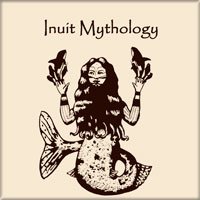
Inuit Mythology
Inuit mythology is the traditional belief system of the Inuit people, who live in the Arctic regions of Alaska, Canada, and Greenland. Here are a few examples of famous myths from Inuit mythology:
The story of Sedna
Sedna is the goddess of the sea and marine animals in Inuit mythology. She is known for her role as the provider of food and is often invoked to ensure a good hunt.
The story of the Raven
The Raven is a powerful trickster figure in Inuit mythology and is known for his intelligence and cunning. He is often depicted as the creator of the world and is considered a bringer of culture and wisdom to the Inuit people.
The story of the Inuit ancestor
The Inuit ancestor is the first human being created by the god, Raven. This figure is considered as the first ancestor of the Inuit people, and his children are considered as the founders of different Inuit tribes and clans.
The story of the spirits
Inuit mythology is rich with different kind of spirits, such as animal spirits, ancestor spirits, and nature spirits, who are believed to have great power and influence over the natural world.
The story of the shamans
In Inuit mythology, shamans are considered as powerful intermediaries between the human and the spiritual world. They are known for their ability to communicate with spirits and to heal the sick through their spiritual powers.
These myths, along with others, are used by the Inuit people to explain the origins of their people and their customs, and to reinforce their traditional beliefs and values. The Inuit traditional religion was based on animism, ancestor worship, and shamanism.
Norse mythology is the body of myths of the North Germanic peoples, stemming from Norse paganism
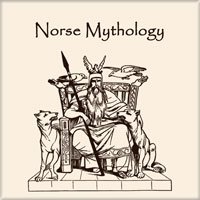
Norse mythology is the body of myths of the North Germanic peoples, stemming from Norse paganism and continuing after the Christianization of Scandinavia, and into the Scandinavian folklore of the modern period.
Norse mythology is the traditional belief system of the people of Scandinavia, which includes the myths, legends, and religious beliefs of the ancient Norse. Here are a few examples of famous myths from Norse mythology:
- The story of the creation of the world: According to Norse mythology, the world was created by the god, Odin, Vili and Ve. They created the world from the body of the giant Ymir.
- The story of Thor: Thor is the god of thunder and is known for his strength and courage. He is often depicted as a fierce warrior, wielding a powerful hammer.
- The story of Odin: Odin is the chief of the gods and is known as the All-Father. He is the god of wisdom, poetry, and war, and is often depicted as a one-eyed old man.
- The story of Loki: Loki is the trickster god of Norse mythology and is known for his cunning and wit. He is often depicted as a shape-shifter and is considered a bringer of chaos and mischief.
- The story of Ragnarok: Ragnarok is the end of the world in Norse mythology, where gods, giants and monsters will fight in a great battle that will ultimately lead to the death of many gods and the destruction of the world.
These myths, along with others, are used by the Norse people to explain the origins of their people and their customs and to reinforce their traditional beliefs and values. Norse mythology is polytheistic, with a pantheon of gods and goddesses, and it was an important aspect of the Norse religion.
The Sami people are an indigenous people of the Arctic regions
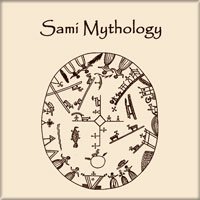
According to the Sámi world view, man and nature were one. To the Sámi people, nature was home, a way of life, the past and the future. In the Sámi world view, as in that of other arctic peoples, the well-being of man and nature alike was directly dependent upon the balance between the two.
The Sami people are an indigenous people of the Arctic regions of Norway, Sweden, Finland, and Russia. Their traditional belief system is known as Sami mythology, which includes a rich collection of myths, legends, and religious beliefs. Here are a few examples of famous myths from Sami mythology:
The story of the creation of the world: According to Sami mythology, the world was created by the god, Radien-attje, who is the supreme god and creator of the universe.
The story of the Sami ancestor: The Sami ancestor is the first human being created by the god, Radien-attje. This figure is considered as the first ancestor of the Sami people and his children are considered as the founders of different Sami tribes and clans.
The story of the spirits: Sami mythology is rich with different kind of spirits, such as animal spirits, ancestor spirits, and nature spirits, who are believed to have great power and influence over the natural world.
The story of the shamans: In Sami mythology, shamans are considered as powerful intermediaries between the human and the spiritual world. They are known for their ability to communicate with spirits and to heal the sick through their spiritual powers.
The story of the Nattravnen: Nattravnen is a spirit of the night, known for its ability to shape-shift and for its mischievous nature. It is often depicted as a bird or an owl.
These myths, along with others, are used by the Sami people to explain the origins of their people and their customs and to reinforce their traditional beliefs and values. The Sami traditional religion was based on animism, ancestor worship, and shamanism.
The myth of the eight-headed serpent, Yamata no Orochi
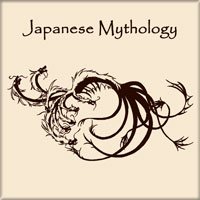
Japanese mythology encompasses the folk traditions of Japan and the Shinto religion. It is a collection of stories, beliefs, and customs that have been passed down through generations. The stories often revolve around the creation of the world, the deeds of the gods and goddesses, and the lives of heroes and monsters.
Famous Myths of Japanese Mythology
-
The myth of the creation of Japan
According to Japanese mythology, the god Izanagi and goddess Izanami were responsible for the creation of the Japanese islands. They stood on the bridge between heaven and earth and dipped a spear into the water, creating the first island of Onogoro.
-
The myth of Amaterasu
Amaterasu is the goddess of the sun and the ancestor of the Imperial Family of Japan. She is said to have been offended by her brother's behavior and retreated into a cave, causing the world to become dark. Her eventual return to the world brought light and warmth back to the land.
-
The myth of Susano-o
Susano-o is the god of sea and storms, as well as brother of Amaterasu. He is known for his reckless and impulsive behavior, which often causes trouble for the other gods.
-
The myth of the eight-headed serpent, Yamata no Orochi
Yamata no Orochi is a giant serpent with eight heads and eight tails, who terrorized an ancient province in Japan. He was eventually defeated by the god Susano-o, who saved a maiden and her brothers from the serpent's attacks.
-
The myth of the Tengu
Tengu are supernatural creatures that are half-human